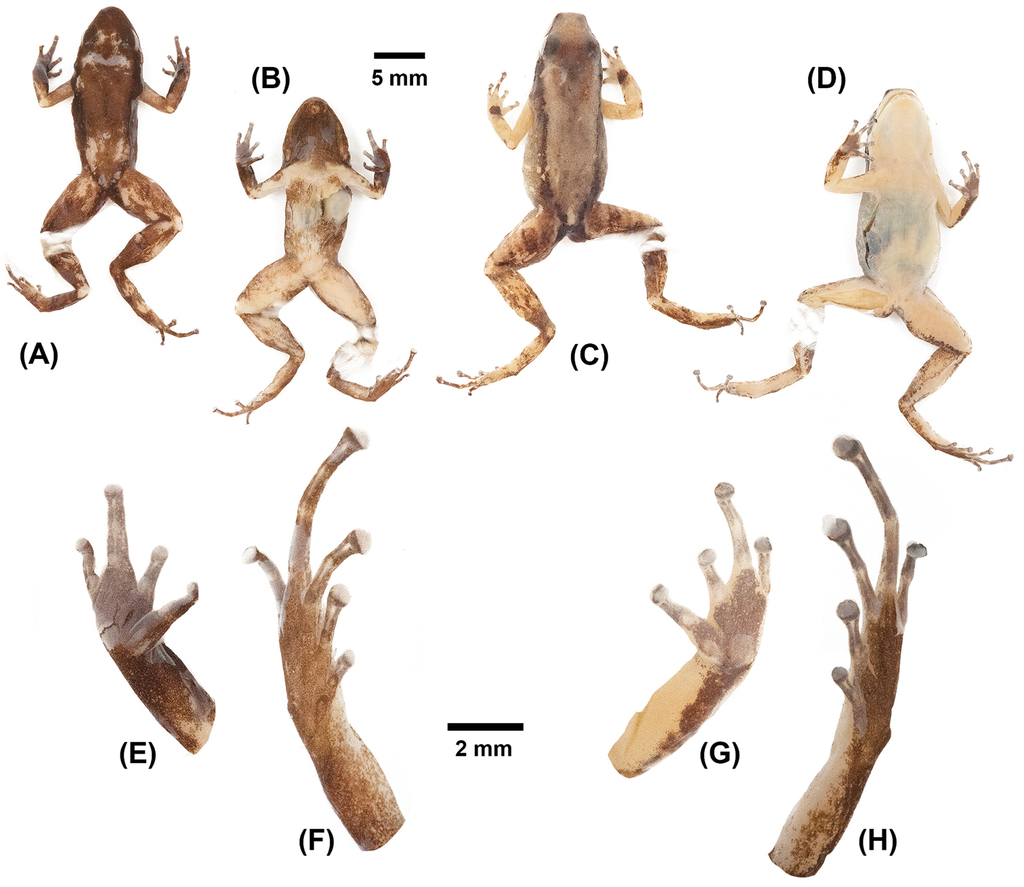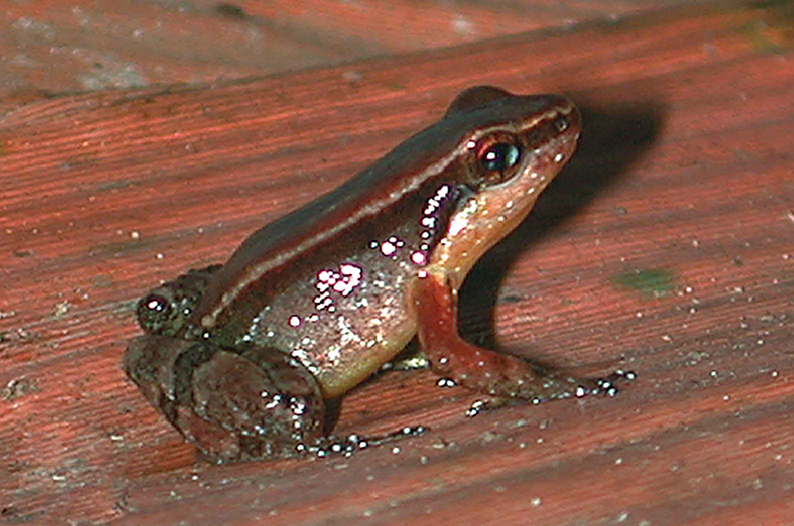Anomaloglossus meansi: The Hidden Jewel of South America’s Rainforests#
Introduction#
Hidden amidst the dense foliage and moss-laden rocks of South American rainforests dwells a small yet remarkable amphibian—the Means’ Rocket Frog, scientifically known as Anomaloglossus meansi. Often unnoticed by passing eyes, this tiny jewel of a creature embodies the incredible biodiversity that thrives in these vibrant ecosystems. Though diminutive in size, measuring less than three centimeters in length, Anomaloglossus meansi plays an oversized role in the ecology of its forest home, signaling environmental health and captivating those fortunate enough to glimpse its secretive life.
The Means’ Rocket Frog belongs to a group of frogs renowned not only for their striking colors and cryptic behaviors but also for their sophisticated chemical defenses, intricate breeding strategies, and vital ecological roles. But despite its impressive natural adaptations, this elusive amphibian faces growing threats—from habitat degradation to climate change—that demand our urgent attention.
Taxonomy and Classification#
Anomaloglossus meansi belongs to the expansive amphibian order Anura, within the diverse family Aromobatidae—a group distinct from poison dart frogs (Dendrobatidae) though equally captivating in beauty and behavior. Within this family, the genus Anomaloglossus is particularly noted for its variety of small-bodied frogs adapted to highly specialized habitats ranging from montane streams to undisturbed leaf litter.
This species was first formally described by herpetologists Grant, Rada, Anganoy-Criollo, Batista, Dias, Jeckel, Machado, and Rueda-Almonacid in 2017. Named after renowned herpetologist Bruce Means, in honor of his extensive research and conservation work on South American amphibians, Anomaloglossus meansi continues to intrigue the scientific community for its unique adaptations and secretive habits.
Natural Habitat#
Geographic Range and Distribution#
The Means’ Rocket Frog is endemic to a very restricted range within the cloud forests and montane rainforests of the Guiana Shield, primarily found within areas like the Gran Sabana region of southeastern Venezuela and adjoining regions in western Guyana. These ancient landscapes, characterized by their mist-shrouded tepuis and cascading rivers, provide an ideal microhabitat for Anomaloglossus meansi.
Habitat Preferences#
Primarily terrestrial, this species thrives in the humid understory and leaf litter of mature tropical forests. They favor habitats close to crystal clear streams, where moisture levels are consistently high, and leaf litter offers ample shelter. These frogs particularly rely on pristine moss-covered logs, rocky crevices, and dense leaf litter patches, making them exceptionally sensitive to alterations in their habitat.
To catch a fleeting glimpse of this elusive frog, observers must often gently lift damp leaf litter or inspect mossy banks, noticing subtle movements or hearing their faint yet distinctive advertisement calls resonating softly among the forest undergrowth.
Physical Characteristics#
The delicate physique of Anomaloglossus meansi camouflages superbly into its surrounding environment, making sightings a rare treasure. This species typically reaches lengths between 16mm to 23mm, classifying it among the smaller-sized aromobatid frogs.
Their coloration exhibits shades of browns, bronzes, and dark olivaceous hues, marked by subtle patterns or faint marbling—a visual strategy superbly designed for blending seamlessly into rainforest leaf litter. Upon closer inspection, observers might note intricate dorsal markings or grooving that mimic leaf veins, and small, well-developed limbs adapted precisely for agile movements and careful navigation across damp, uneven terrain.
However, beneath this innocuous appearance lies an extraordinary adaptation: the skin of aromobatid frogs, including Anomaloglossus meansi, often harbors mild alkaloids—defensive chemicals that deter predators. Though less toxic than their dendrobatid counterparts, these frogs’ defenses nonetheless attest to their adaptive brilliance.
Behavior and Life Cycle#
Diet and Predatory Habits#
As a voracious insectivore, the Means’ Rocket Frog meticulously hunts small arthropods including ants, termites, mites, and tiny beetles. Their hunting strategy combines stealthy ambush with quick reaction times—often remaining stationary beneath camouflage leaf litter layers until prey ventures unknowingly close, at which point the frog launches forward with astonishing speed.
Breeding and Reproductive Patterns#
Breeding seasons typically coincide with periods of increased rainfall when moisture availability peaks, ensuring adequate environmental conditions for egg development. During courtship, males emit soft, cricket-like calls from concealed positions within leaf litter or nearby vegetation, attracting females into their hidden tableau.
Uniquely, aromobatid frogs like Anomaloglossus meansi exhibit careful parental investment—a behavior unusual for many frog species. Females lay tiny clutches of eggs in carefully chosen, moisture-rich microhabitats, such as damp leaf clusters or niches near streams. Males often remain vigilant guardians, regularly moistening the eggs and defending them fiercely against opportunistic predators like ants or insects.
Tadpoles hatch within the humid micro-environment before being carried or guided by the adults to nearby water sources, typically shallow pools or seeping streams. Here, they undergo metamorphosis hidden carefully within vegetation and submerged debris before emerging as fully formed frogs, continuing their secretive yet ecological-critical lifestyles.
Ecological Role#
The importance of Anomaloglossus meansi transcends its diminutive stature. It serves as both predator and prey within highly dynamic rainforest ecosystems, maintaining delicate ecological balances. By consuming vast quantities of insects—many considered forest pests—it naturally regulates arthropod populations, effectively maintaining plant health and ecosystem stability.
Additionally, as sensitive bio-indicators, aromobatid frogs hold intrinsic scientific value. Researchers closely monitor their populations, health, and behaviors, recognizing trends or sudden population shifts as important early signs of ecological disturbances, such as pollution or habitat alteration.
Threats and Conservation Status#
Due to its limited geographical distribution and specialized habitat preferences, Anomaloglossus meansi is particularly vulnerable to environmental threats. Habitat degradation posed by illegal mining, deforestation, invasive species, and climate change presently loom large, threatening to disturb the delicate conditions in which it thrives. These impacts can rapidly drive localized populations to decline, given their limited dispersal ability and habitat specialization.
The International Union for Conservation of Nature (IUCN) has yet to finalize assessment categorizations due to the recent description, yet early studies already signal conservation concern.
Increasingly, conservation organizations advocate protecting forest areas within their habitat, as pristine, untouched forest corridors ensure genetic diversity and population stability. Sustainable ecotourism efforts, public awareness campaigns, and scientific research further support conservation ambitions, providing hope for this extraordinary frog’s sustained survival.
Cultural and Scientific Significance#
While not widely recognized in traditional cultural contexts due to its secretive existence, the Means’ Rocket Frog holds significant scientific allure. Amphibian researchers regard this species as essential for understanding evolutionary adaptations to highly specialized habitats, chemical defenses, and amphibian reproductive behavior.
Moreover, its naming honors renowned herpetologist Bruce Means, whose longstanding dedication illustrates the profound connections between passionate scientists, nature lovers, and the fragile wildlife they strive tirelessly to protect.
Conclusion#
Anomaloglossus meansi embodies the hidden beauty and intricate complexity of South American rainforests. Its remarkable adaptations, important ecological role, and inherent sensitivity to environmental change all underline the urgency of protecting such species. Understanding and engaging with efforts to preserve frogs like Anomaloglossus meansi reminds us of our shared responsibility to guard the invaluable biodiversity that makes our planet endlessly fascinating.
Let the Means’ Rocket Frog serve as inspiration, urging us all to contribute, however small our actions, toward conservation initiatives. Together, we can ensure future generations continue to marvel at these secretive gems hidden within our world’s most precious ecosystems.


















